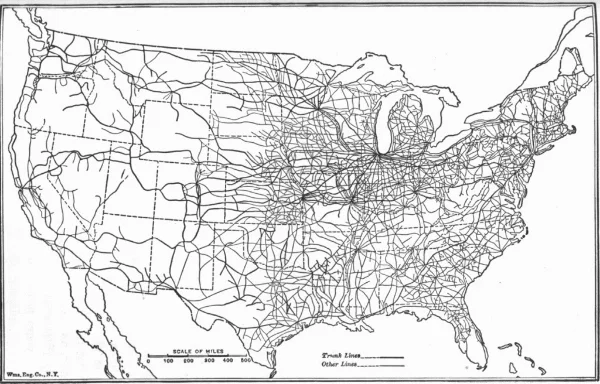Rail map in the 19th century
One of the most talked-about efforts in the world of transportation is underway in Florida: All Aboard Florida's effort to build and operate passenger rail service between Miami and Orlando. The service is privately funded and the intent is to be profitable. It's also worth noting that it's not high-speed rail, but low-speed rail (max speeds of 125 MPH). Henry Grabar has an in-depth look at the service this week at CityLab. Here's a few key items:
Can All Aboard Florida establish a blueprint for how private freight railways, which averted financial ruin by abandoning passenger service, can profit from its revival? "If it can work there, it could work in other markets. The other private rail firms absolutely can be watching this," says Adie Tomer, an associate at the Brookings Institution Metropolitan Policy Program who studies passenger rail. "This a great test for America."
...
All Aboard Florida, however, has a couple of inherent advantages. The first is in its infrastructure. As a corporate descendent of the Florida East Coast Railway, AAF owns an easement for passenger service on a long, centrally located, well-maintained freight corridor. The second is demographic. On the strength of Disney World, Universal Studios, and other theme parks, Orlando is the most visited city in the United States, with nearly 60 million tourists last year. Miami, with its global cachet and thriving cruise ship port, counted 14 million visitors in 2013. All Aboard says that there are 500 million trips made every year between its destination cities.
So AAF will set a passenger railway in motion. With 32 trips each day and a train capacity of 400 travelers, the service can theoretically carry more daily riders between Miami and Orlando than Amtrak's Acela does between New York and Washington, D.C. Tourists and in-state leisure travelers will account for nearly three-quarters of AAF ridership, with business travelers making up the rest. (It's virtually the inverse of the Acela's business-heavy traveler ratio.)
"Our expectation is that the train will be profitable, in and of itself," says John Guitar, senior vice president of business development at AAF.
The whole piece is worth a read if you have any interest in infrastructure, transportation funding or redevelopment. I'm optimistic the "experiment" will work and help to usher in a wave of interest in new passenger rail in the US. That said, I still think there's a good option for cities to take the lead themselves, as I wrote previously here, if they don't want to wait for rail companies or Amtrak to do it. Let the experimenting begin.
If you got value from this post, please consider the following:
- Sign up for my email list
- Like The Messy City Facebook Page
- Follow me on Twitter
- Invite or refer me to come speak
- Check out my urban design services page
- Tell a friend or colleague about this site

